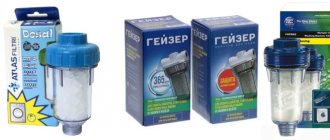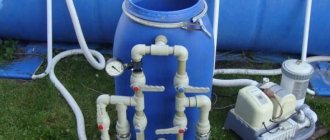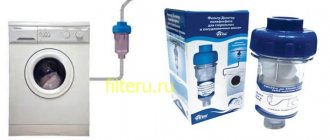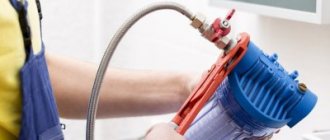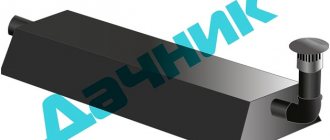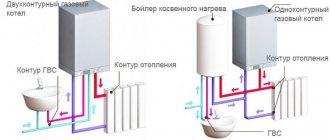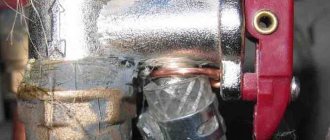In the field of water treatment and purification, there is one very serious problem - any filter material periodically becomes clogged, which means it needs to be replaced or cleaned (regenerated).
In order to minimize the cost of cartridges or bulk material, self-cleaning water filters have been developed.
Such systems are so far capable of purifying liquid only from mechanical particles. Some industrial models can regenerate the properties of bulk filter materials to a greater extent by washing them under pressure.
This approach significantly increases the service life of the backfill material and the operation of the filter as a whole.
Operating principle of a self-cleaning system
Filter for mechanical water purification with self-cleaning function.
During operation, liquid enters the filter through the inlet and, following through a mesh installed in its flask, leaves mechanical impurities on it. Gradually, a sufficient amount of dirt accumulates on the mesh, which must be removed. If there is no self-cleaning filter, you need to periodically perform the following actions:
- turn off the water
- unscrew the body
- remove the mesh and rinse under running water,
- Reassemble the system in reverse order.
This system does not require replacing cartridges or removing them for cleaning.
The presence of a self-cleaning water filter eliminates unnecessary worries. With the help of a special drain ball valve, the deposit of settled mechanical particles is washed off with a stream of water from the surface of the mesh.
The benefits that self-cleaning filters provide are obvious:
- you won’t have to spend money on paying a plumber when you need to clean out the septic tank again;
- maintenance time is saved, since the entire procedure takes place quite quickly;
- the expenditure side of the budget will be reduced, since there will be no need to buy replacement cartridges;
In addition, some devices allow you to not interrupt the water supply when washing the filter.
Purpose of coarse filtering
The first place to use such a device is ordinary water. Tap water (for an apartment), borehole, well water (for a cottage) may contain “garbage” that interferes with its operational or consumer properties. Thus, particles of sand or delamination from pipes clog the aquatic environment, creating a threat to humans, plants, and delicate equipment (double-circuit boiler, gas water heater, flow-through or storage heater).
An important negative role is played by suspensions in an autonomous heat supply system, when a dirty coolant based on water or special antifreeze damages fragile elements of the heat supply system (heat exchanger, copper heater tubes).
A coarse filter that can retain (filter) unnecessary components and remove them from the system will help correct the situation. The reusable operating mode of the filter device allows you to significantly save on other methods of purifying liquids.
Installation Features
It is recommended to install the self-flushing mechanism after the shut-off valves behind the water meter. The installation principle is not complicated.
- The device is located in a vertical position with the bulb down, occupying a small space. The liquid enters through the inlet pipe, passes through the cleaning cells, leaving dirt and impurities on them, after which it is supplied under pressure to the tap.
- At the bottom of the flask there is a hole that is closed during normal operation of the filter. If the pressure becomes weak, it needs to be opened. The flow of liquid will begin to press down, and the filter will be washed. After which the valve closes again.
- Some models are designed to connect a drainage hole to the sewerage system. If this possibility is not provided by the developers, when washing, a container is installed under the device to collect liquid.
The degree of purification depends on the density of the filter element. The denser the material and the smaller the cells, the better the final result and the more often the devices will have to be washed.
Key advantages of self-cleaning filters
Self-washing devices have a lot of advantages, perhaps the main one is the opportunity to save on the purchase of cartridges, which over time still have to be thrown away, because. their service life is very short.
- Save on purchasing new cartridges.
- Possibility of cleaning without stopping the water supply.
- High-quality water purification – fine and coarse.
- Requires minimal maintenance.
- Prices affordable for most.
So, if you are seriously thinking about improving the quality of your tap water, we recommend that you pay attention to such an effective and economical device as a self-cleaning water filter.
Terms of use
In order for the filtration system to optimally perform its function, you need to make sure that the water fully complies with the conditions for using such a device.
It is not advisable to install the cleaning system near heating systems. It is also necessary to monitor the pressure in the system: if there is high pressure in the system, the filter may fail, and you will spend a lot of money on repairs.
When using such a cleaning filter regularly, it is necessary to wash the mesh. Flushing should be carried out approximately every six months. If washing is necessary earlier, then this can be easily determined by the water pressure, and if the flasks with cleaning elements are transparent, then you can see the degree of contamination.
In order to wash safely, it is necessary to use the specified amount of water to wash the mesh. If the amount of water is increased, then some element of the system may fail.
There are many water purification systems sold in our markets, but choosing the right option for you is difficult without a specialist. And you also shouldn’t install such systems yourself. It is better to use the services of specialized companies. Such companies will provide you with a large list of their services.
An overview of some models of self-cleaning water filters can be seen below.
Kinds
Based on the size of the captured impurities, they are divided into:
- Fine filter capable of catching pieces of rust and sand 20–50 microns in size.
- Coarse cleaning devices that allow filtration of elements with a size of 100–500 microns.
Depending on the temperature of the liquid, filters for cold and hot water are distinguished:
- For cold water.
Devices for cold water often have a transparent body, which is very convenient: you can “by eye” determine how dirty the filter element is.
- Mesh filter for hot water. It has a more durable design that can withstand significant temperatures without problems. Its “cold” counterpart will be deformed under such conditions, so you should not confuse them.
Based on the nature of the cleaning element, the following filters can be distinguished:
- Mesh. The most common and least “capricious” design. Such devices have a special turbine that accelerates water, which cleans the mesh. There is no need to stop the system.
- Disk. More expensive and demanding. You can often find such water filters with backwashing, which is not always available with mesh ones. They have greater productivity.
According to the cleaning method, self-cleaning filters are:
- Hand washable. This does not mean that you will have to remove the filter element from the system. The procedure can be carried out even without stopping the water supply. But manufacturers still recommend removing and washing the mesh separately. Although this is not a very convenient procedure, it will have to be performed much less frequently than replacing replacement cartridges. In addition, it does not require any financial costs.
- Semi-automatic. For such models, you will only have to manually give the cleaning command directly; the system will do all the work itself. In different models from different manufacturers, self-cleaning filters are cleaned differently, much depends on the type of cleaning element and the design of the unit.
- Automatic. The process is started thanks to the readings of various sensors. Another option is that cleaning is performed according to a preset timer.
The last two varieties can rarely be seen in a separate apartment. Such self-cleaning units are most often used on high-pressure water mains, which serve to supply water to swimming pools or entire houses.
Self-cleaning filters can be equipped with various accessories:
- Pressure gauge. It is especially convenient if these devices are located before and after the filter system. Then, by the pressure difference on the pressure gauges, you can judge the degree of contamination of the device and promptly clean it.
- Pressure reducer. Protects the entire system, including the filter, from water hammer during sudden changes in pressure in the water supply.
Characteristics of flow filters
Type.
Mainline technical filters cut directly into the water pipe and are usually used for initial water purification.
By design, main filters can be divided into two types: mechanical cleaning filters with backwashing and housing filters for standard cartridges of various sizes. Which one should I put where?
A washable filter is installed for rough purification of water from large mechanical impurities - sand, rust and other inclusions with a size of 100 microns. This filter does not require replacement of cartridges; if the filter element is very dirty, it can be washed.
Washing is carried out by opening the tap located at the bottom of the filter housing - in this case, the dirt particles accumulated on the filter mesh are washed into the drain with a stream of water. To be able to monitor the degree of contamination of the filter, its body is sometimes made transparent. For the same purpose, the filter is often equipped with a pressure gauge - if there is another pressure gauge at the entrance to the apartment (or house), then the clogging of the filter can be monitored by the pressure drop.
Such a filter will not be able to purify water from chemical and microbiological contaminants, and even mechanical particles less than 50 microns in size will pass through it freely. But if you have another stage of mechanical cleaning, this filter cannot be considered superfluous - it will retain large particles and extend the life of the cartridge in the next filter.
Housing filters are more versatile - depending on the installed cartridge, they can remove mechanical inclusions up to 1 micron in size (mechanical cartridges), hardness salts, iron (ion exchange) and microbiology (carbon, silver, etc.) from water. The filter size is selected depending on the planned flow rate and water contamination.
Flow drinking filters are designed for the preparation of drinking water and are usually installed in the kitchen. All flow-through drinking filters can be divided into two types:
— using standard cartridges (K87X, SL10);
- using original manufacturer cartridges.
The most versatile and economical option is multi-stage filters for SL10 cartridges - cartridges of this type are the most common, have a low price and sufficient resource. You can easily select the necessary cartridges (according to water analysis) and install them in a filter with the appropriate number of stages. The only disadvantage of such a filter is that it is somewhat difficult (and “dirty”) to replace the cartridges.
Filters based on K87X cartridges are compact, look impressive, and replacing their cartridges is unlikely to puzzle even a child. But the resource of such cartridges is much shorter, their performance is also low, but the price is even higher than that of the SL10.
Filters based on original cartridges may be more attractive in price or size, but keep in mind that replacing a non-standard cartridge may cause problems. Not to mention choosing a cartridge of a different type than the one installed in the filter (for example, ion exchange instead of carbon) - the cartridges you need may simply not be produced by the manufacturer.
A reverse osmosis system is the most “advanced” type of flow-through drinking filter. They differ from conventional multi-stage filters by the presence of a special filter stage - a reverse osmosis membrane. The pores of such a membrane are about 0.1 nanometer in size, which allows it to pass only pure water and some gases, while retaining all larger molecules.
Such filters provide the maximum degree of water purification, but they also have some disadvantages:
— the filtration rate of reverse osmosis filters is very low; it makes no sense to use them without a storage tank;
— with reverse osmosis filtration, a considerable amount of water goes into the drainage;
— for such a filter to operate, a water supply pressure of at least 3-4 bar is required. If the inlet pressure is below 3 bar, a pressure boosting pump should be used.
The faucet attachment is the most budget-friendly type of flow filter, easy to install and operate. However, it should be understood that the resource of such a filter is several times less than that of full-size filters based on 10SL cartridges.
Therefore, it makes sense to use such filters only on fairly clean water and at low flow rates, otherwise they will become clogged quite quickly. Considering that most filter attachments are disposable, the seemingly low price of such a filter can quickly lead to unexpectedly high costs.
When choosing a filter, it is advisable to know the pressure in the water supply system.
If the minimum filter pressure is greater than the pressure in your network, the filter performance will be low (or even zero). Network pressure greater than the maximum filter pressure can lead to leakage of filter connections or even failure. For urban water supply networks, the standard pressure value is 4 bar. However, in some areas the pressure can be higher - up to 5 bar, and due to water hammer it can briefly rise to 6-7 bar.
Therefore, for a city apartment (especially a new one and located on the lower floors), it is better to take a model with a reserve of maximum pressure. In private homes, the pressure is usually set at 2-3 bar - for some multi-stage filters this may not be enough.
A high pressure pump can help if the water pressure in the water supply is lower than required. The pump will create the required pressure in front of the filter and provide certified performance for any water supply parameters.
The storage tank is used with filters with low productivity. Thanks to the storage tank, you can, for example, quickly fill a large saucepan that would otherwise take a long time to fill in a thin stream.
to the maximum water temperature when selecting a filter for hot water - especially if plastic is used as the body material . When heated, its performance characteristics decrease; hot water can damage the plastic case, even if its pressure is within acceptable limits.
The service life of filter elements (cartridges) shows how much water the filter can clean before replacing the cartridges. If you do not replace the cartridges when their resource is exhausted, the quality of filtration will decrease. The total resource for disposable filters is equal to the resource of the filter element, and for filters with replaceable cartridges it indicates the reliability and durability of the design. In order to understand exactly what the resource of the selected filter is enough for, you can use the table:
On average, one person spends 3000–4000 liters of cold water and 1500–2000 liters of hot water per month. Although the spread here is very large - for some, consumption may be 10 times higher, and for others, 2-3 times lower.
The properties of the filtered water should also be taken into account. The passport life of a cartridge is usually calculated based on the degree of contamination of 1-2 maximum permissible concentrations. If your water is dirtier, the resource will decrease accordingly.
The filtration rate determines the speed of water flow through the filter at which the declared purity of the filtered water will be ensured. In some cases (for example, for reverse osmosis filters), the filtration rate does not depend on the flow rate, and it is almost impossible to exceed it. But with main filters the situation is different: if the current flow rate exceeds the rated value of the filtration rate, the quality of the water leaving the filter will be worse. Therefore, flow filters should be selected according to the planned flow rate on the filtered pipe. For washing hands and dishes, a flow rate of 4-6 l/min is required, for taking a shower - 10-12 l/min.
The number of filters ( number of purification stages ) is selected as needed - based on water analysis. For example, if the analysis reveals an excess of iron and microbiology, and the water itself contains virtually no mechanical impurities, then three cartridges will be sufficient - mechanical cleaning at 5-10 microns, ion exchange and carbon. If the water is dirty (contains a lot of mechanical particles), instead of one mechanical cleaning cartridge, you will need to install 2-3 stages with different porosities.
Filters, depending on the cartridges installed in them, can perform various functions:
— mechanical cleaning;
— reverse osmosis>;
— sorption – absorption of organic compounds, toxic substances, bacteria and other contaminants, depending on the sorbent used;
- ion exchange - removal of hardness salts and dissolved iron from water;
– elimination of odors – absorption of aromatic molecules;
- mineralization - saturation of water with microelements.
The type of connection to the pipeline largely determines the ease of installation and maintenance of the filter. A threaded connection is the most reliable and durable, but installing a filter with such a connection will require some plumbing skills.
The size of the threaded connection must match the size of the thread on the water pipe to which the filter is connected.
Quick connect fittings like john guest are very easy to connect, but the problem is that there are no matching fittings of this type on water pipes.
Many manufacturers complete flow filters with a ball valve-tee with a threaded connection on one side and a john guest fitting on the other. If such a valve is not included in the kit, you will have to purchase it separately.
Options for selecting in-line filters
To clean tap water from sand and rust, a main filter with backwashing is suitable - it is convenient because it does not require replacing cartridges.
A housing main filter will help purify water for the washing machine, shower and dishwasher - or for the entire apartment at once. Just don't forget to install the appropriate cartridge in it.
A flow-through drinking filter with reverse osmosis will provide you with the purest drinking water - such filters provide the maximum degree of purification.
The faucet attachment will help purify water with minimal effort - but keep in mind that the service life of such filters is short.
Increased hardness is one of the main problems of our tap water. A filter with an ion exchange function can solve this problem.
Rating of the best models and manufacturers
When choosing a faucet attachment option, you should pay attention to the products of the Aquaphor company. The operating speed can vary from 300 ml to 1 l per minute
The resource also varies among drugs: the indicator values can be 750-3000 liters. The manufacturer claims that only substances harmful to humans are removed, while the beneficial properties of the water are preserved.
Flow-through water filter Aquaphor Crystal Eco
This flow-through filter for drinking water is installed under the sink.
It has 3 stages of purification: using ion exchange, carbon and ultraviolet filtration. There is no storage tank, but the system works quickly (2.5 liters are processed within a minute), so if necessary, you can get clean water without a long waiting period.
The device is capable of processing 8000 liters of water, after which it will require replacement. Installation of such a system is not too difficult. The cost of the device is low: you only have to pay 3,500 rubles, and the device will last a long time, which makes it a profitable purchase.
Flow-through water filter Barrier Expert Hard
This option, produced on the territory of the Russian Federation, is considered not too expensive: you will only have to pay about 2900-3000 rubles. The main advantage is the extended service life. The resource of the device is 10,000 liters. Additionally, there is a water softening function.
Flow-through main water filter Geyser Prestige P
This model is the only one on the market that creates the pressure required for proper operation. Manufacturer: Russian company.
The advantages are:
- 5 stages of flow purification, allowing you to obtain a liquid almost completely free of impurities;
- the presence of a container for storing purified water with a volume of 12 liters;
- iron retaining and softening systems.
HelpfulUseless
Modifications of fine water filters
- F74 series are made of a plastic body with a transparent filter bowl, available with threaded connections 3/4″, 1″, 1 1/4″, designed for cold water purification, thanks to the rotating flange they can be mounted on a vertical or horizontal pipeline.
- F76 series in brass body with glass bowl and brass bowl for cold and hot water purification,
- F76S series flanged for industrial cleaning, with connecting flanges with a diameter from 65 to 125 mm.
Fine water purification filters prevent the penetration of foreign bodies, such as rust particles or grains of sand, which can have a detrimental effect on equipment downstream of the filter. The products comply with the requirements of the current DIN/DVGW specifications.
Advantages
A filter that cleans itself has many advantages. With the help of such advantages, you can save your time, since there is no need to regularly replace filters, and the system itself has a long service life. That is, the owner saves not only his time, but also finances.
The main advantages of such systems:
- if flushing is performed, there is no need to shut off the water supply;
- this filter is able to perform its function without interruption;
- the ability to replace system elements with newer ones, for example, you can install a mesh with smaller cells.
These are not all the advantages of a self-cleaning water purification system
If we take into account even the above advantages, it becomes clear that this cleaning principle is convenient to use and very profitable
Combination filters
Combination strainers deserve special attention - universal devices that combine the reliability and functionality of a filter and a pressure reducer. Filters protect equipment from the destructive effects of small solid particles. Pressure reducers protect household appliances and plumbing fixtures from the effects of excess water pressure in the main and water hammer, reduce water consumption, and minimize the noise of water behind it. When the increased water pressure in the water supply is normalized, non-target water consumption sharply decreases, for example, when washing hands, brushing teeth, while taking a shower, etc.
Most reducers are designed with a balanced seat to maintain a constant set pressure even with wide variations in inlet pressure.
Classification
These devices are divided according to the following factors:
- according to the orientation of the settling tank,
- according to washing methods,
- according to the type of connection to the pipeline.
Let's take a closer look at each type of mesh filter.
According to the orientation of the sump
The outlet for dirt accumulation can be located at a right or acute angle relative to the central axis of the filter:
- A perpendicular mud trap is usually larger in size than an oblique one. A straight sump is installed horizontally, pointing downwards. This design requires space under the pipe.
- The oblique bend has smaller dimensions. It is installed in vertical areas, pointing downwards. You can place the filter on a horizontal pipe located a short distance from the floor.
Important. Any type of sump requires periodic cleaning
Therefore, during installation, you need to provide free access, which will allow you to easily unscrew the plug and remove the mesh.
By type of connection to the pipeline
Strainers can be connected to the water supply in different ways. According to this criterion, they are divided into two groups:
- coupling;
- flanged.
The coupling connection is designed for pipelines with a diameter of up to 2 inches. These types of devices are screwed onto pipes, then the joint is secured with union nuts.
Flange filters are installed on lines with a diameter exceeding 2 inches. The joints are secured with studs or bolts. If necessary, such structures can be easily removed.
By washing method
Any mesh water filters clog sooner or later. Approaches to their purification vary.
There are three main types of structures:
- flushing;
- non-washable;
- self-cleaning.
Non-flushing devices
Non-flushing devices are usually small in size. To clean, you need to unscrew the cap on the case and manually remove dirt.
Important. During the cleaning of non-flush structures, the water supply to the pipeline is shut off. Advantages of such filters:
The advantages of such filters:
- simplicity,
- low price,
- reliability,
- small sizes.
The affordability of the price is explained by the use of budget materials, so often the devices do not last very long. Some users don't like the cleaning requirement.
Flushing
Flushing systems have a glass-shaped body under the mesh. There is a hole at the bottom of the container. When the ball valve is closed, part of the flow flows into the glass, washing away the accumulated dirt.
Rinse water is collected in a bucket or directed through a hose into the sewer. Such devices provide direct water supply.
There are other designs on sale in which the wash water is supplied from below. Reverse flow removes buildup from the housing and mesh even more effectively. These devices last longer.
The water supply does not stop when cleaning the wash filters.
The advantages of flushing structures are ease of cleaning, reliability, and durability. There are practically no disadvantages. Some users do not like the noticeable size of the filter and the need to clean it themselves.
Self-cleaning
The most convenient and most expensive types of filter mesh devices are washed automatically. You don't need to keep track of them. The mud pan and mesh are cleaned according to the time set on the timer. Some models respond to a decrease in inlet pressure.
Installing a pressure gauge before the filter, sometimes also after the filter, is useful for all mesh devices. Changes in pressure indicators are a reliable indicator of the condition of the mesh and sump.
Attention. The operation of the filter is regulated automatically and does not require shutting off the water supply. The advantages of the device are its convenience
The filter is durable and does not require time and effort to clean. Not all users like the need to connect the device to the electrical network or sewerage
The advantage of the device is its convenience. The filter is durable and does not require time and effort to clean. Not all users like the need to connect the device to the electrical network or sewerage.
In the case of repairs, you have to look for a specialist with a high level of competence. Such a product requires a lot of free space and is expensive.
How to choose the right self-cleaning filter
Tips for choosing will be as follows:
- First of all, you need to decide on all the parameters of the system in which the unit will be installed. This includes water pressure and temperature.
- It is necessary to make sure that the diameters of the pipes and filter connections match. Or think about options for fitting them.
It is better to purchase self-cleaning filters from well-known manufacturers. You can rely on reviews from friends and acquaintances. This will protect you from unnecessary surprises and save money and time.
Installation and connection methods
Installed product
Installation of a self-cleaning filter is carried out on horizontal metal or plastic pipes using flanged or threaded connections
It is important that the filter bowl faces down. Another key aspect is that the filter on the main line is installed only in front of the meter
Many models are designed in such a way that when cleaning the filter element it is not necessary to turn off the entire system, turn off the water and remove the filter itself from the pipe. However, experts recommend installing valves to shut off the water supply during repairs or replacements. It is also desirable that the pressure gauge is clearly visible at the installation site.
What will happen to the equipment if its existence is forgotten?
It will remind you of itself when the taste of the liquid changes or the supplied stream decreases to a minimum size. After unscrewing the flask and removing the block, you will see terrible brown mud deposits and smell a putrid smell. You can buy new elements and replace them according to the scheme we described above. But try to do the treatment yourself using improvised means (citric or formic acid, vinegar or ammonia) at home.
Editor's Choice
The most suitable and convenient option for purchasing mesh filters for an apartment is a set of filters for cold and hot water
Set of mesh filters atoll FF06-1/2A+AM - designed for purifying hot and cold water from sand, silt, and rust. The grid cell size is 100 microns. It catches the bulk of contaminants and represents the first stage in multi-stage water treatment systems, protecting subsequent stage filters and household appliances from mechanical impurities and thereby extending their service life many times over.
If the pressure is not stable, then it is better to choose a model of the atoll FK06 series with a pressure reducing valve.
